The Rhody Survivalist ~ Online Resources
Rhody Survivalist: Water
Water, the lifeblood of the earth is something that most of us take for granted. A person can only live for about 3 days without water. An average person will need about a gallon per day. Fortunately, even in the dryest deserts a survivalist can find drinkable water. If you're ever in a pinch and need to find water, watch the local birds and animals. They will teach you how to find water. It is still up to you to purify it into a form that a human can drink.
When looking for a water source you should look for non-stagnant clear running water. Springs, where the water comes out of the earth are ideal. Most freshwater sources can be purified into drinkable water, be very aware of polluted water sources. Downstream of factories, treatment plants, junkyards, etc are usually not good sources. Once you locate a good souce of water be sure you don't polute it. All waste should be disposed of at least 100 yards and down-stream of your water source. This is also true of your washing area and your animal processing area, be sure these are far from both your camp and your water source. Also, be sure to never eat snow, melt and boil it first. Eating snow could actually dehydrate you more. In your progression to primitive you should have purification tablets in your ditch bag for quick purification on the go. You should also have a backpacking filter which may last you about a year. After that you will have to boil all your water. If you have a metal pot, you can do this on a fire, if not you will have to make a container and start rock boiling. Remember when boiling water a minimum of 5 minutes is required and 20 minutes is reccomended.
Spring Identification:
Locating a spring can be like finding gold when in a survival situation. In the winter time springs are fairly obvious because they don't freeze. Any time you find water coming out of the ground in the winter time you can be rather comfortable identifying it as a spring. There is no way however, to be certain. You should still purify ALL the water you drink.
Video on Winter Spring ID
One way to locate a spring is to follow running water up hill to the source. Often a spring won't be as obvious as it may be in the middle of a swamp or a pond. Some of the springs I have found have had a sandy spot in the middle of a muddy area where turbidity was actually apparent in the spot that the water came out of the ground. Most spring water is exactly 55 deg. F which is another way to be more certain you have found a spring. One note of caution: Springs are becoming increasingly dangerous to drink from. Chemical contaminants are finding their ways into pristine water supplies faster than ever before. A spring will most likely be clear of biologic contaminants but chemical contaminants are becoming a very big concern. Very few commercial filters have the ability to filter out chemical contaminants. The process of fracking in for oil and gas extraction purposes is now threatening a huge amount of our nations drinking water. Drink carefully!
Rock-Boiling Water:
Containers:
After a knife the number 1 item to put in your survival kit is a small metal pot. Something you can boil water in. In a real survival situation having some sort of container is a MAJOR advantage. This is one of the few situations where polution works to your advantage. In almost all parts of the world containers in the form of trash can be found. You can actually boil water in found glass bottles directly in a fire PROVIDED THEY ARE FULL! While I have only done this one time per bottle I have head of people getting up to 20 boils in a glass bottle as long as they were carefull not to expose the bottle to too much "thermal shock". Plastics can also be used but be wary of the chemicals that are released into your water. If you are going the all-primitive route, there are several primitive container options:
4 Primitive Container types:
1. Fresh Aimal Skin
2. Animal Stomach
3. Bark Basket
Bark Basket: Bark baskets are fast, easy and fun to make. The problem is you need to kill a tree or take a section from a large tree. You also can only harvest the bark when the trees are "wet" or the sap is running. In the spring the bark will slip right off. In the summer and fall it really depends on the recent rainfall. In the winter you may be out of luck.
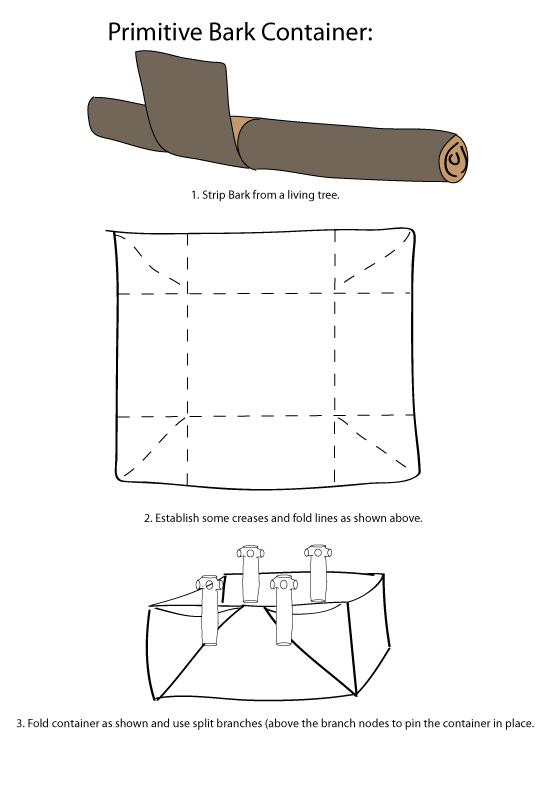
What you should end up with is something like this:
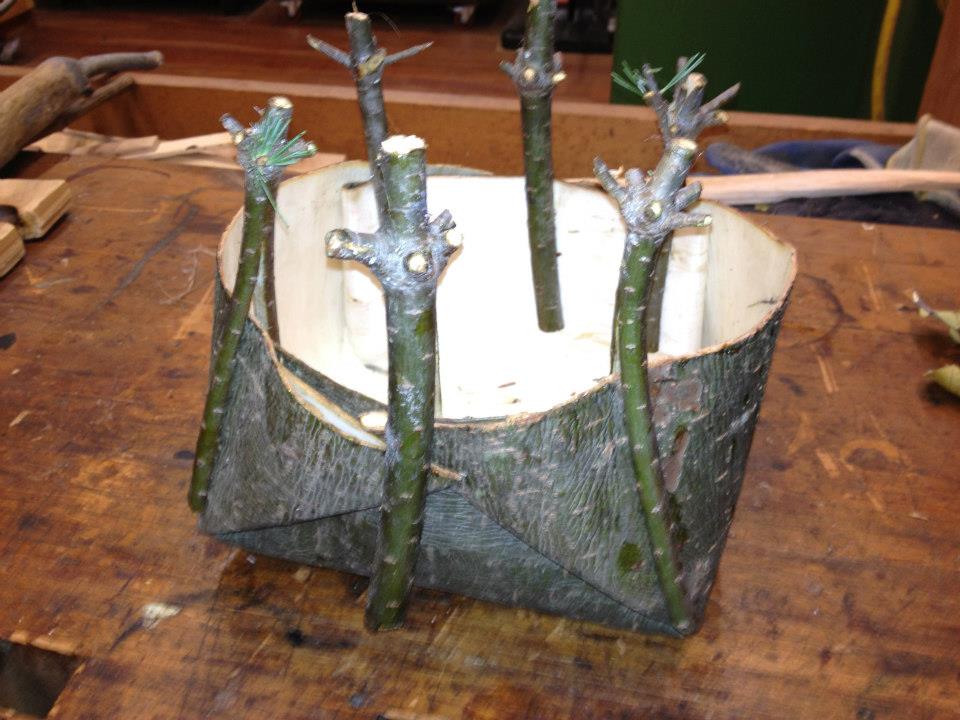
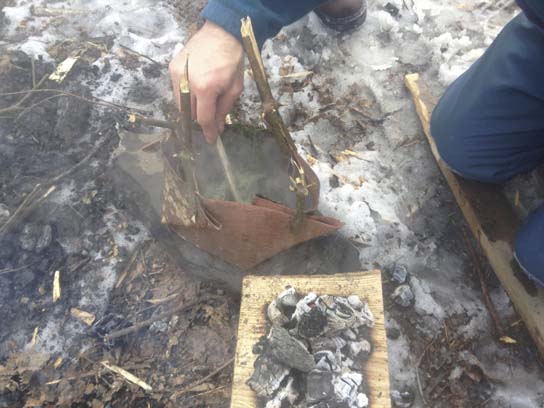
Rock-Boiling Hemlock Tea in a Bark Bowl
4. Burned-In Bowl
Burned-In Bowls: Burned in-bowls are a great way to make eaasy bowls in the wilderness. Just find some wood, set up hot coals on the wood as illustrated in the videos below and in a short amount of time you have a burned in bowl! Occasionally blow on the coals but be careful not to induce fire as it will be too hot and crack your bowl. Occasionally scrape out the charcoal and add fresh coals to keep the process going. If possible allow the wind to blow on your coals for you and work on settig up your survival camp while the wind works for you! Between meals clean the bowl by "flashing" it. Turn it upside down and put it on the fire for a sterilizing quick flash burn. As a rule of thumb water should be boiled (rolling boil) for at least 5 minutes to kill all the bacteria in the water.
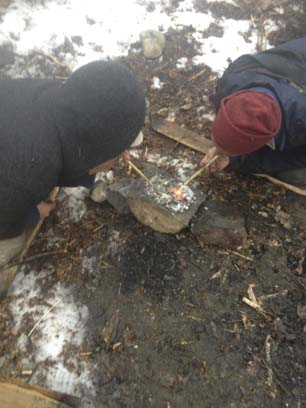
Using Weed Stalk Straws to Burn Out a Bowl
Video: Making a Burned-In Bowl
Video: Making Bowls and Rock Boiling
Water Gathering:
Dew Wipe:
Early in the morning you can wipe dew off of rocks and non-poisonous plants. Absorb with your dew rag and ring into a container. Be sure to boil the collected water.
Plants:
Succulent plants can be collected and water squeezed out. The best are Thistles and Grasses. For Thistles collect before they flower, remove the spines, chew up and suck out the water. The same technique works for grasses. Grasses in wet areas are best. Do not swallow the plant after sucking out the moisture. Grape vines can also be used by cutting the vine about 4-6 feet from the gound and tie off bent over a container, The grape vine will continue to drip into the container for days and a big vine could give up gallons each day. Remember that Grape vines have tendrils. If you don't see tendrils you may be dealing with a poisonous vine.
Tree-Tapping:
A Tapped-Tree can yield sap that when consumed will yield not just needed moisture but needed sugar. You can also use it to make Syrup or concentrated sugar by boiling off the excess moisture. 35-40 gal. of sap yields 1 gal. of syrup. Tappable tree types include: Sycamore, Hickory, Walnut, Birch, Box Elder, and all Maples. A tree should be at least 1 ft. in diameter before tapping. The tree should be tapped on the southern exposure or sunny side of the tree.
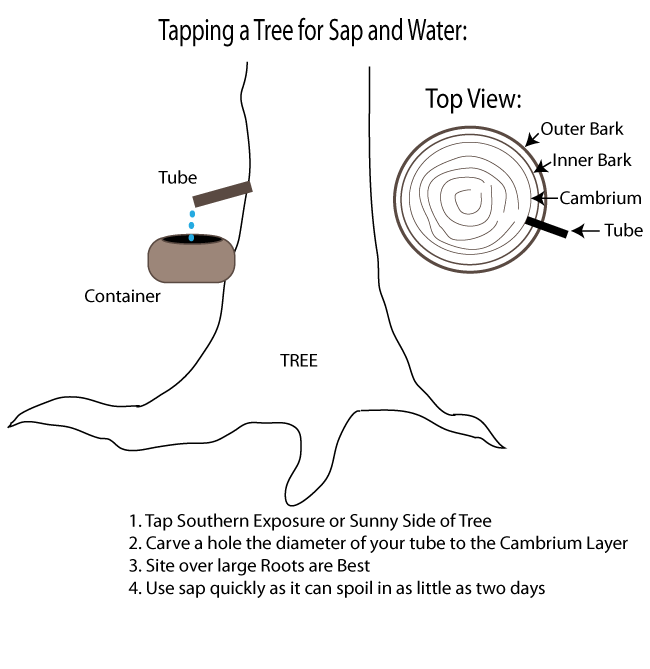
Be sure to plug the hole you left in the tree with a plug or pitch. Tree tapping is FAR more effective in the spring when the sap is running strong. I have tried to tap trees in the off season and found that the amount of liquid derived from the process is not worth the potential damage to the tree. Also, you need to protect your sap from critters. After just one night of collecting sap I found my sap container full of earthworms who climbed up the tree and found their way into the sap container and drown. Ants and other bugs love sap too. Finally, birds will perch on your container to drink you sap and have a nasty habbit of defecating in the sap. So keep your sap protected, covered and collect it often!
The Solar Still:
The solar still can be an effective way of making water. All you need is a 6ft. by 6ft. sheet of clear plastic, 5ft. of plastic tubing, a container and a small stone. Set up as shown below:
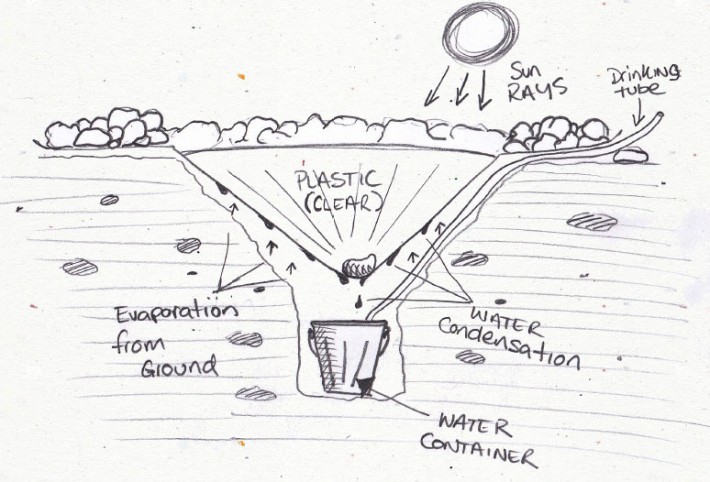
You can speed up the process by putting water, damp foliage or other moist materials in the hole. Another technique is to put a plastic bag on trree branches sealed at the base. Moisture will evaporate out of the branches and drip into the bottom of the bag. Be sure to use non-poisonous folliage.
Primitive Filter:
Primitive filters are a great way to make water SAFE. They are not great at making water clear and tasty. Remember that a primitive filter is keeping you alive and healthy. After some time, you get used to the taste of charcoal. Below is the Leatha S. Warden version of a primitive birch bark filter as posted at: http://wildwoodsurvival.com/survival/water/lswbirchbarkfilter.html
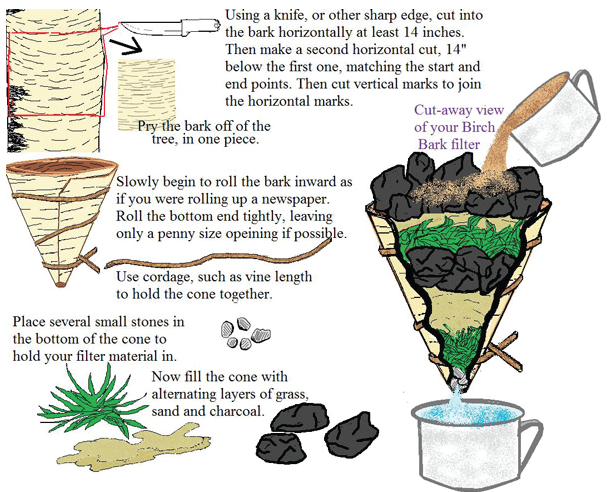
Diagram is Copyright 2008 Leatha S. Warden
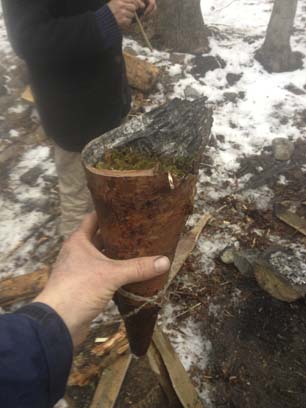
A Birch Bark Water Filter We Built at Roots.
Other Resources:
FEMA GUIDE to FOOD and WATER in an EMERGENCY: http://www.fema.gov/pdf/library/f&web.pdf